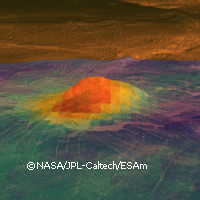Volcanic activity offers clues to (geological) life on Venus
Earth's closest neighbour, Venus, may still be geologically active, the European Space Agency (ESA) has announced. The ESA's Venus Express spacecraft has identified young lava flows that reveal the planet is still able to produce volcanic eruptions. The discovery supports the theory that volcanoes are behind the planet's unusually smooth surface. Findings from the study are published in the journal Science. Unlike other planets, Venus has a sparse and largely unmodified crater population. This fact has generated debate amongst scientists over whether the planet was resurfaced after a particular catastrophic event or gradually over a period of time. For instance, can large-scale and quick volcanic activity be attributed to resurfacing the entire planet with lava or is it more likely to be the result of a slower progression of smaller volcanic eruptions? In their study, the scientists identified nine volcanic hot spots on Venus that may be active. The sites are similar to those in Hawaii in that they are believed to sit on top of mantle plumes (rising masses of hot molten rock). Of the nine volcanic regions discovered, compositional differences in lava flows were identified at three specific sites. These were classified using heat data returned by the Visible and Infrared Thermal Imaging Spectrometer (VIRTIS) onboard the Venus Express, which has been orbiting the planet since April 2006. VIRTIS provides an estimate of emissivity (i.e. the ability of a material to release or radiate heat) by recording the brightness of surface rocks. When compared to surrounding landscapes, the scientists concluded that lava flows at the three hotspots emit unusually high amounts of heat. They write: 'We estimate the flows to be younger than 2.5 million years, and probably much younger, likely 250,000 years or less, indicating that Venus is actively resurfacing.' Their findings suggest that the planet's surface may be the result of smaller volcanic eruptions taking place gradually over time. Venus and Earth are both similar in size and in internal heat production. Results from this study suggest they may have more in common. On Earth, the flow of lava reacts with oxygen and other elements resulting in changes in the composition of matter. The process could be similar on Venus, although more intense since the planet's atmosphere is hotter and denser. 'There are some intriguing models of how Venus could have completely covered itself in kilometres of volcanic lava in a short time, but they require that the interior of Venus behaves very differently from Earth,' explained Dr Sue Smrekar from the National Aeronautics and Space Administration's Jet Propulsion Laboratory in the US. 'If volcanism is more gradual, this implies that the interior may behave more like Earth, though without plate tectonics,' Dr Smrekar concluded.



